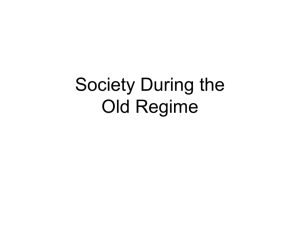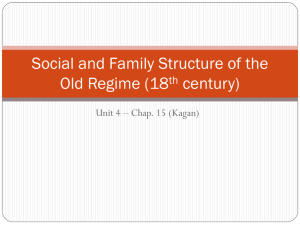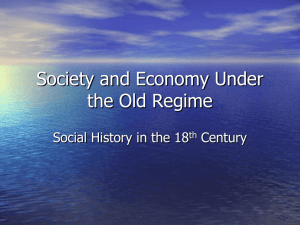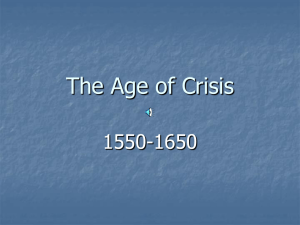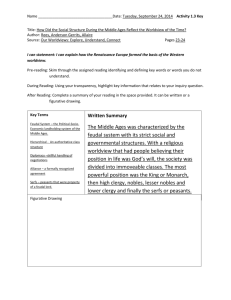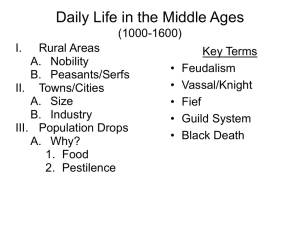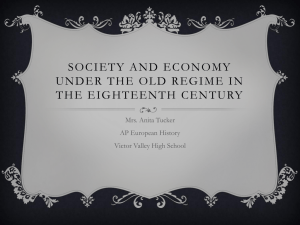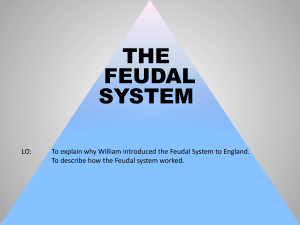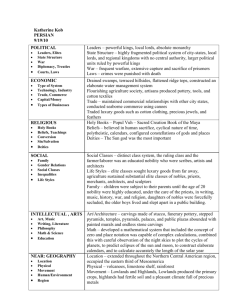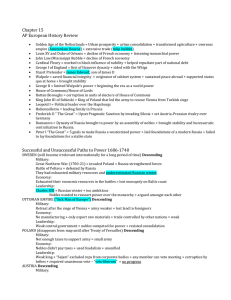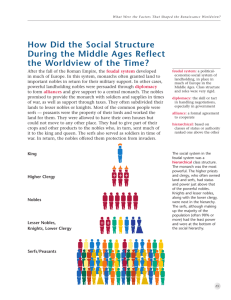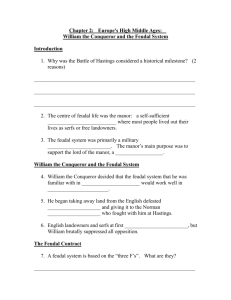Western Civilization II
advertisement
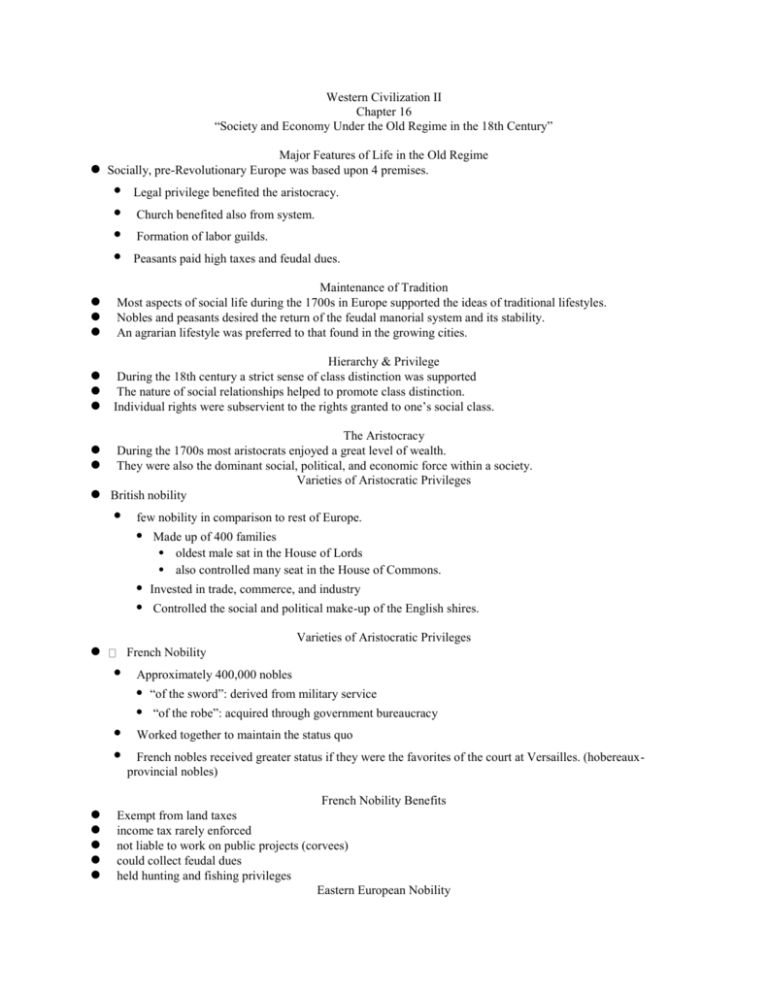
Western Civilization II Chapter 16 “Society and Economy Under the Old Regime in the 18th Century” Major Features of Life in the Old Regime Socially, pre-Revolutionary Europe was based upon 4 premises. • • • • Legal privilege benefited the aristocracy. Church benefited also from system. Formation of labor guilds. Peasants paid high taxes and feudal dues. Maintenance of Tradition Most aspects of social life during the 1700s in Europe supported the ideas of traditional lifestyles. Nobles and peasants desired the return of the feudal manorial system and its stability. An agrarian lifestyle was preferred to that found in the growing cities. Hierarchy & Privilege During the 18th century a strict sense of class distinction was supported The nature of social relationships helped to promote class distinction. Individual rights were subservient to the rights granted to one’s social class. The Aristocracy During the 1700s most aristocrats enjoyed a great level of wealth. They were also the dominant social, political, and economic force within a society. Varieties of Aristocratic Privileges British nobility • few nobility in comparison to rest of Europe. • Made up of 400 families • oldest male sat in the House of Lords • also controlled many seat in the House of Commons. • Invested in trade, commerce, and industry • Controlled the social and political make-up of the English shires. Varieties of Aristocratic Privileges • • • French Nobility Approximately 400,000 nobles • “of the sword”: derived from military service • “of the robe”: acquired through government bureaucracy Worked together to maintain the status quo French nobles received greater status if they were the favorites of the court at Versailles. (hobereauxprovincial nobles) French Nobility Benefits Exempt from land taxes income tax rarely enforced not liable to work on public projects (corvees) could collect feudal dues held hunting and fishing privileges Eastern European Nobility Military traditions of these nobles important. Poland • • • • Szlachta exempt from all taxes controlled the life and death of serfs most were relatively poor political power controlled by handful of wealthy nobles Austrian-Hungarian Nobles Exempt from most taxes Prince Esterhazy of Hungary • • probably the wealthiest noble in Europe controlled over 10 million acres of land Prussia Prussian nobles called “Junkers” dominated the military and Prussian bureaucracy also controlled the local courts Russia Peter the Great linked state service with social status • Table of Ranks • Charter of Nobility • enacted by Catherine the Great • service became voluntary Russian nobles controlled the courts were exempt from taxes Autocratic Resurgence When Catherine the Great issued the Charter of the Nobility, it helped to define the expanding power of the nobility throughout most of Europe. • • • • idea of state service resisted by Russian nobles Made their status more exclusive used feudal rights to check the power of the monarchs improved their financial status The Land and Its Tillers Three-fourths of the people in the 18th century lived in the country. Besides the nobles and nonaristocratic landowners, most of the people were poor. Lived in a variety of economic and social states. Peasants and Serfs Peasants • free peasants • owned their own small plots of land • paid feudal dues (banalites) • owed a corvee (labor on public projects) Serfs • bound to the land (slavery) • • • not used for military service considered property if they could escape for 1 year they were free Peasant Rebellions Pugachev Rebellion (Russia) • serfs had been promised land and freedom Other revolts occurred throughout eastern Europe Few revolts occurred in western Europe • England did see some rural riots over legal issues Family Structure In preindustrial Europe the household was the basic unit of production and consumption. Since most people lived in rural areas and were self-sufficient, the “family economy” developed throughout much of Europe Households of Western and Eastern Europe Western Europe • nuclear family • 5-6 members plus servants • high mortality and late marriage (mid 20s) deterred the extended family • neolocalism Eastern Europe • • • • early marriage extended families of 10 to 20 people patrilocal many were serfs and large families were needed to maintain a proper labor supply The Agricultural Revolution New Crops • clover and turnips New Methods • • use of manure as fertilizer crop rotation • instead of leaving a field fallow, a crop that renewed the soil and provided animal fodder was used (Charles “Turnip” Townsend) Other Innovations Jethro Tull invented the seed drill. Robert Bakewell, pioneered methods in animal husbandry. Agricultural publications • Annals of Agriculture (England) • edited by Arthur Young Enclosure Movement Put more soil into crop production replaced the old “triennial system” • • unpopular with small farmers common lands were seized by large landowners or nobles by use of legal means. Since the movement increased production, labor did not diminish Population Expansion Europe’s population in 1700 was approximately 100 to 120 million. By 1800, it was about 190 million. Growth was seen throughout Europe. Increased food supplies allowed for the growth. • Potatoes fueled this growth • 1 acre of potatoes / feed a family for a year The Industrial Revolution Agricultural Developments Revolution in Agriculture Dutch- Dikes to stop flooding and used fertilizer from animals. British- Mixed soils to improve yields. Robert Bakewell- Selective Breeding led to stronger horses for use in the fields. Fences were used to keep livestock in pastures and wild animals off cropland (Enclosure Movement) Jethro Tul And His Seed Drill Planted seeds in straight lines, rather than scattered, which allowed for the use of his other invention, the horsedrawn hoe. Revolution in the Textile Industry Jay Kay’s flying shuttle was faster than spinners. James Hargreaves Spinning Jenny spun many threads at the same time. Richard Arkwright’s waterframe used water power to speed up spinning. Samuel Crompton’s Spinning Mule combined features of the Spinning Jenny and the Water Frame. Produced stronger, finer thread; created demand for factories, because supply of thread exceeded the weavers ability to use. Revolution in Power James Watt redesigned the steam engine to use coal as a a power source instead of water. At first the steam engines were used to pump water and forge iron, and later powered cotton mills.
